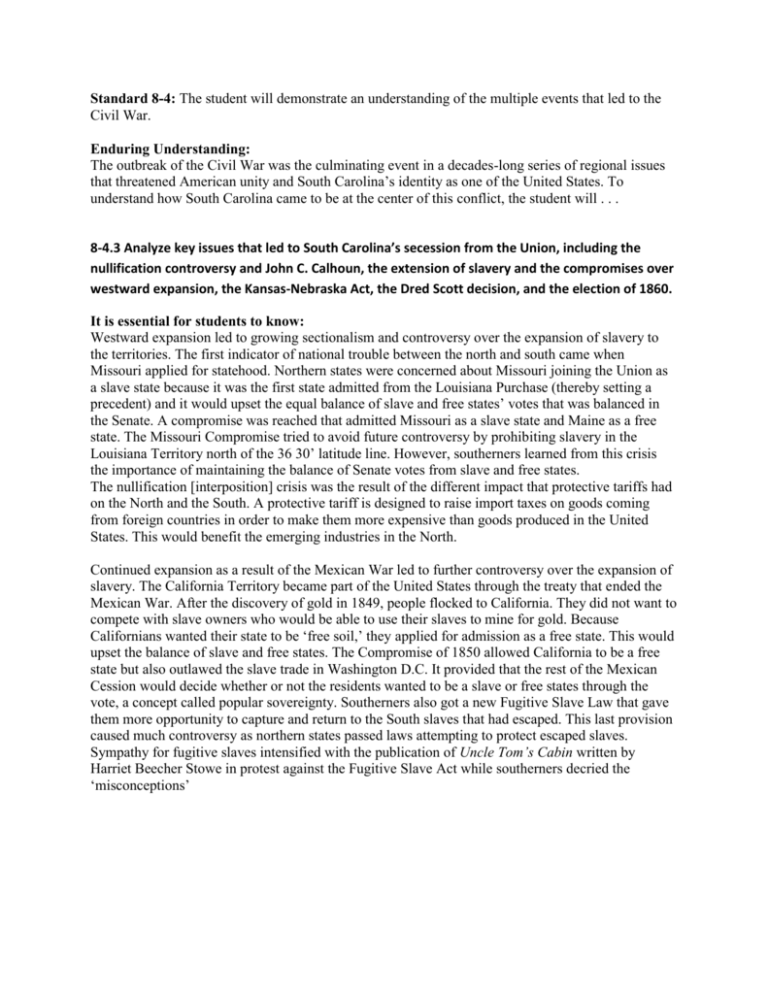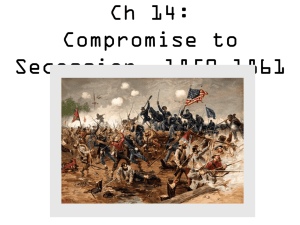Standard 8-4: The student will demonstrate an understanding of the
advertisement

Standard 8-4: The student will demonstrate an understanding of the multiple events that led to the Civil War. Enduring Understanding: The outbreak of the Civil War was the culminating event in a decades-long series of regional issues that threatened American unity and South Carolina’s identity as one of the United States. To understand how South Carolina came to be at the center of this conflict, the student will . . . 8-4.3 Analyze key issues that led to South Carolina’s secession from the Union, including the nullification controversy and John C. Calhoun, the extension of slavery and the compromises over westward expansion, the Kansas-Nebraska Act, the Dred Scott decision, and the election of 1860. It is essential for students to know: Westward expansion led to growing sectionalism and controversy over the expansion of slavery to the territories. The first indicator of national trouble between the north and south came when Missouri applied for statehood. Northern states were concerned about Missouri joining the Union as a slave state because it was the first state admitted from the Louisiana Purchase (thereby setting a precedent) and it would upset the equal balance of slave and free states’ votes that was balanced in the Senate. A compromise was reached that admitted Missouri as a slave state and Maine as a free state. The Missouri Compromise tried to avoid future controversy by prohibiting slavery in the Louisiana Territory north of the 36 30’ latitude line. However, southerners learned from this crisis the importance of maintaining the balance of Senate votes from slave and free states. The nullification [interposition] crisis was the result of the different impact that protective tariffs had on the North and the South. A protective tariff is designed to raise import taxes on goods coming from foreign countries in order to make them more expensive than goods produced in the United States. This would benefit the emerging industries in the North. Continued expansion as a result of the Mexican War led to further controversy over the expansion of slavery. The California Territory became part of the United States through the treaty that ended the Mexican War. After the discovery of gold in 1849, people flocked to California. They did not want to compete with slave owners who would be able to use their slaves to mine for gold. Because Californians wanted their state to be ‘free soil,’ they applied for admission as a free state. This would upset the balance of slave and free states. The Compromise of 1850 allowed California to be a free state but also outlawed the slave trade in Washington D.C. It provided that the rest of the Mexican Cession would decide whether or not the residents wanted to be a slave or free states through the vote, a concept called popular sovereignty. Southerners also got a new Fugitive Slave Law that gave them more opportunity to capture and return to the South slaves that had escaped. This last provision caused much controversy as northern states passed laws attempting to protect escaped slaves. Sympathy for fugitive slaves intensified with the publication of Uncle Tom’s Cabin written by Harriet Beecher Stowe in protest against the Fugitive Slave Act while southerners decried the ‘misconceptions’ about slavery that the book portrayed. The Kansas-Nebraska Act was also the result of westward expansion and north/south economic competition. The Kansas Territory was in the northern part of the Louisiana Territory so according to the Missouri Compromise it could not be a slave state. However, some politicians wanted to build a railroad across the country through Kansas and they needed to get southern support. Southerners, especially Jefferson Davis, wanted to build a transcontinental railroad on a southern route from New Orleans. The Kansas-Nebraska Act repealed the 36◦ 30’ line of the Missouri Compromise. It allowed people in these territories to decide for themselves whether or not to allow slavery within their borders through ‘popular sovereignty.’ In order to affect that vote (not the way the concept of popular sovereignty was supposed to have worked!), northern abolitionists and southern slave owners temporarily moved into the Kansas Territory. Soon their fighting led people to call the area “Bleeding Kansas.” Some northern Whigs and northern Democrats who were appalled at the violence joined with the Free Soil Party (those opposed to the expansion of slavery) and the Liberty Party (abolitionists) to form a new political party: the Republicans. The Dred Scott decision was an attempt by the Supreme Court to end the controversy over the role of free states in determining the status of the enslaved. Dred Scott was a slave whose master had taken him into free territory. With the help of northern abolitionists, Scott sued his master for his freedom claiming ‘once free, always free.’ The Supreme Court decided that African Americans were not citizens of the United States, even if they had been born in the United States, and therefore they had no right to sue in the Supreme Court. In fact, the court said they had no rights at all. However, the court went on to rule that Scott was property and that the Constitution of the United States protects the owner of property from having that property taken away by the government. The court further ruled that Congress could not pass measures such as the Missouri Compromise or the Kansas Nebraska Act limiting the expansion of slavery into the territories. Such acts were ruled unconstitutional because they denied the slave owner the right to take his property anywhere that he wanted. The Dred Scott decision did not end the controversy over slavery. Instead, northerners claimed that the court would deny them the right to outlaw slavery in their states and would end the idea of popular sovereignty, limiting democracy. South Carolinians applauded the decision and accepted the Supreme Court’s ruling as the final word on the issue. Debates over the Dred Scott decision led Republican Abraham Lincoln to national prominence and further split the Democratic Party. Abolitionist John Brown’s raid on the federal arsenal at Harper’s Ferry and the publicity that surrounded his trial further heightened sectionalism by stoking the fears of southern slave owners that abolitionists and freed slaves would be a danger to their lives as well as their livelihoods. Many southerners had also come to believe their interests would be gravely threatened by the election of a northern, Republican candidate. The election of 1860 prompted South Carolina to secede from the Union. Republican Abraham Lincoln campaigned on a platform of ‘free soil’. “Free soil’ is the idea that slavery should not be allowed to expand to the territories. Lincoln was not an abolitionist in 1860, but a free-soiler. Lincoln won the election with electoral votes from the North. The South and border states split their votes among several candidates. After Lincoln’s election, however, South Carolina called a special convention and signed Articles of Secession claiming that the rights of South Carolinians had not been and would not








